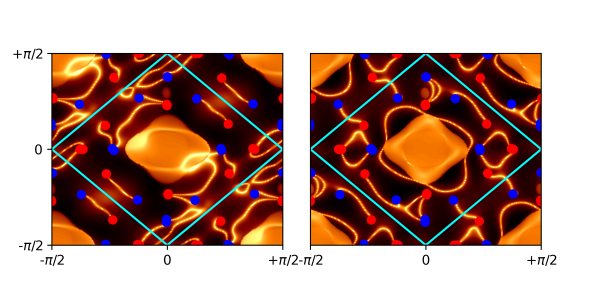Computational study points to a promising Weyl semimetal
By Nicola Nosengo - NCCR MARVEL
In a textbook case of how computational studies can point to promising innovative materials for hi-tech applications, scientists in Nicola Marzari’s group at EPFL have singled out a compound of indium, manganese and titanium (InMnTi2) that appears to be a rare example of Weyl semimetal. That is, a topological material with unusual electrical conductivity that would make it interesting for several applications in quantum technologies, lasers, or advanced optics. These properties are due to the presence of characteristic nodes in the electronic structure of the material, points where the energy of electrons change suddenly following a mathematical law first described by the mathematician Hermann Weyl. Only few Weyl semimetals have been observed experimentally so far. This study, published in Physical Review Research, predicts InMnTi2 to be relatively easy to synthesize and with well-controllable properties.
The material had been identified by scientists in the same lab in a previous high-throughput study that had looked at over 5,000 compounds from various databases in search of potential topological materials. The search had resulted, among other things, in three candidate Weyl semimetals, and InMnTi2 immediately looked like the most interesting one. But a detailed description of the position of the Weyl nodes was still missing, explains Davide Grassano, a scientist in the THEOS group at EPFL and first author of the study, together with Luca Binci and Nicola Marzari. In addition, the group wanted to study the magnetic behavior in greater detail, to make sure that it would still result to be a Weyl semimetal once all the complications of a magnetic material containing transition metals such as manganese and titanium had been kept into account.
While the previous high-throughput study was based on DFT with the PBE functional, here the group decided to use DFT + U, which more accurately models the localization of electrons. And instead of choosing the U parameter empirically, as it is often done, the scientists here computed it entirely from first principles, in a way tailoring the parameters for this specific physical system.
The results not only confirm that InMnTi2 is a Weyl semimetal, but they also reveal some intriguing details.

Surface states for both the titanium and indium terminated surfaces of InMnTi2. The red and blue dots represent the projection of Weyl nodes with chirality +1 and −1. The Fermi arcs going from nodes of opposite chirality can be observed. Adapted from Grassano et al., Phys. Rev. Res. (2024).
“What is interesting is that the distance between the Weyl nodes appears to be wider than what previous studies suggested, which is good” says Grassano. This large distance ensures that the material’s Weyl properties are well pronounced and kept in various conditions, and that it does not become a Dirac semimetal – still interesting, but different.
What is less positive is that there are some points in the electronic structure that go above a critical energy level called Fermi level, and this can in turn compromise the Weyl behavior and become a problem in technological applications, leading to more ordinary transport properties. “But it looks like it would be possible to introduce perturbations to lower those energy states artificially”, says Grassano.
Another key difference from the calculations that the same group had done for the high-throughput study concerns the material’s magnetic properties. The previous calculations, with the less accurate PBE method, indicated the material as non-magnetic. “Once we added the U functional it immediately resulted as anti-ferromagnetic”. This is interesting, says Grassano, because antiferromagnetism should allow for the crystal to produce the anomalous Hall effect, a particular phenomenon that happens in some magnetic materials when an electrical current is applied to them, and that can be exploited for memory devices, sensors, or quantum computing.
The next step would be for some experimentalists to synthesize the compound and prove that it actually behaves like a Weyl semimetal in the real world. This cannot be taken for granted, as it was recently shown by a study by Ana Akrap (also a MARVEL member). In that study EuCd2As2, touted for years as a Weyl semimetal in DFT studies, proved to be a magnetic semiconductor in experiments.
But Grassano is confident that results on InMnTi2 can be confirmed. “It is a less complicated material than EuCd2As2, it has transition metals, but it does not have lanthanides like europium that are notoriously difficult to simulate with DFT. We think our magnetic calculations are right”.
Reference
Grassano D., Binci L. and Marzari, N., "Type-I antiferromagnetic Weyl semimetal InMnTi2", Physical Review Research 6, 013140 (2024). DOI: https://doi.org/10.1103/PhysRevResearch.6.013140
Low-volume newsletters, targeted to the scientific and industrial communities.
Subscribe to our newsletter